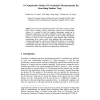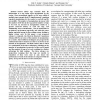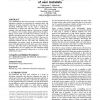HICSS
2007
IEEE
14 years 9 months ago
2007
IEEE
Abstract— The ability to tag resources with uncontrolled metadata or “folksonomies” is often characterized as one of the central features of “Web 2.0” applications. Folks...
AH
2008
Springer
14 years 9 months ago
2008
Springer
In order to navigate huge document collections efficiently, tagged hierarchical structures can be used. For users, it is important to correctly interpret tag combinations. In this ...
ADMA
2008
Springer
14 years 9 months ago
2008
Springer
In recent years, folksonomy becomes a hot topic in many research fields such as complex systems, information retrieval, and recommending systems. It is essential to study the seman...
WCNC
2008
IEEE
14 years 9 months ago
2008
IEEE
—Passive RFID tags transmit their ID information to a tag reader upon energization by the reader. These transmitted signals, or IDs, may collide if multiple tags transmit their I...
RECSYS
2009
ACM
14 years 9 months ago
2009
ACM
Tagging systems have become major infrastructures on the Web. They allow users to create tags that annotate and categorize content and share them with other users, very helpful in...
JCDL
2009
ACM
14 years 9 months ago
2009
ACM
User-contributed tags have shown promise as a means of indexing multimedia collections by harnessing the combined efforts and enthusiasm of online communities. But tags are only o...
ESWS
2009
Springer
14 years 9 months ago
2009
Springer
We consider the problem of tag prediction in collaborative tagging systems where users share and annotate resources on the Web. We put forward HAMLET, a novel approach to automatic...
DEXA
2009
Springer
14 years 9 months ago
2009
Springer
Tagging has become increasingly popular and useful across various social networks and applications. It allows users to classify and organize resources for improving the retrieval p...
CIKM
2009
Springer
14 years 9 months ago
2009
Springer
Social tagging systems have recently emerged as an effective way for users to annotate and organize large collections of resources on the Web. Moreover, they also facilitate an e...
CIKM
2009
Springer
14 years 9 months ago
2009
Springer
Detecting events from web resources has attracted increasing research interests in recent years. Our focus in this paper is to detect events from photos on Flickr, an Internet ima...



